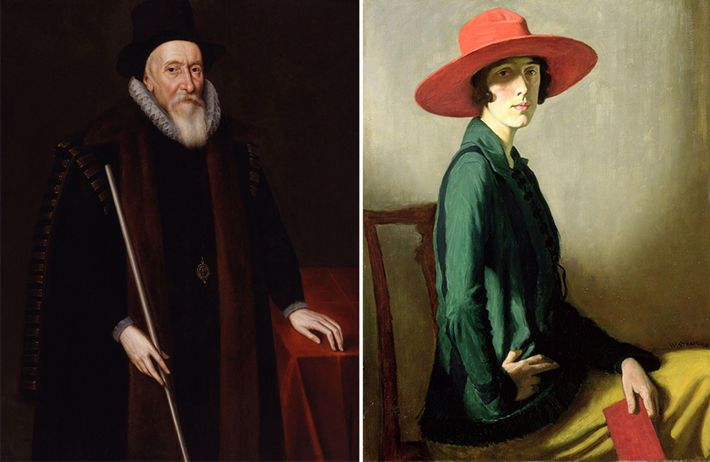Features
Family History
By JARRETT A. LOBELL
Monday, February 01, 2016
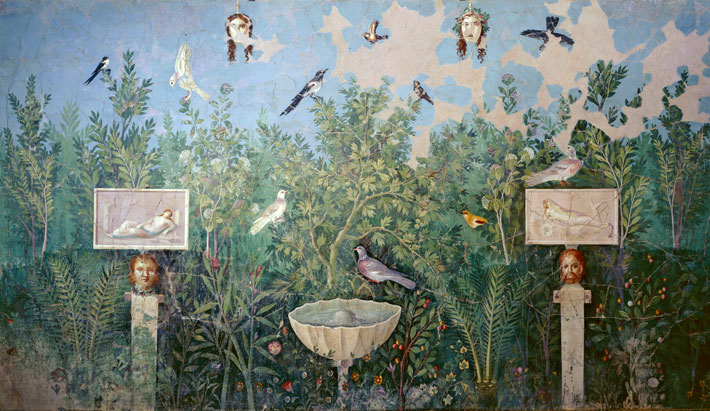
The three-story House of the Golden Bracelet on the Vicolo del Farmacista was one of the most opulent in Pompeii, its walls covered with vibrant frescoes depicting theatrical scenes and imitating expensive marble paneling, its floors paved with intricate black-and-white geometric mosaics. At the rear of the house lay a verdant garden with a splashing fountain and quiet pools, its natural beauty echoed by wall paintings depicting oleander, viburnum, arbutus, bay, palm trees, irises, roses, daisies, and poppies, home to doves and house sparrows, a swallow, a golden oriole, and a jay. From the terrace was a view of the sea, whose breezes cooled the house during hot Mediterranean summers.
The morning of August 24, A.D. 79, was relatively quiet in Pompeii, perhaps disturbed only slightly by a series of earthquakes common enough to the region. But by just past noon things drastically changed, when, according to the first-century Roman writer Pliny the Younger, a cloud of “unusual size and appearance” spewed from nearby Mount Vesuvius. Soon ash, pumice, and stone began to fall, flames could be seen leaping from the mountain, buildings shook and swayed, and, in places, although it was still day, there was “darkness blacker and denser than ordinary night.” For two days, the volcano erupted ferociously, on the first day expelling millions of tons of debris, burying Pompeii at a rate of roughly six inches an hour. Thousands of people were trapped: “You could hear the shrieks of women, the wailing of infants, and the shouting of men; some were calling to their parents, others their children or their wives, trying to recognize them by their voices,” writes Pliny. On the second day, surges of superheated rock, ash, and gases, called pyroclastic flows, rushed down the mountain at speeds of more than 100 miles per hour, flattening the buildings that remained standing, and scalding or perhaps suffocating those who had not already been buried. By the end of August 25, more than 2,000 people likely had died in Pompeii, and at least 15,000 had probably perished in the region.
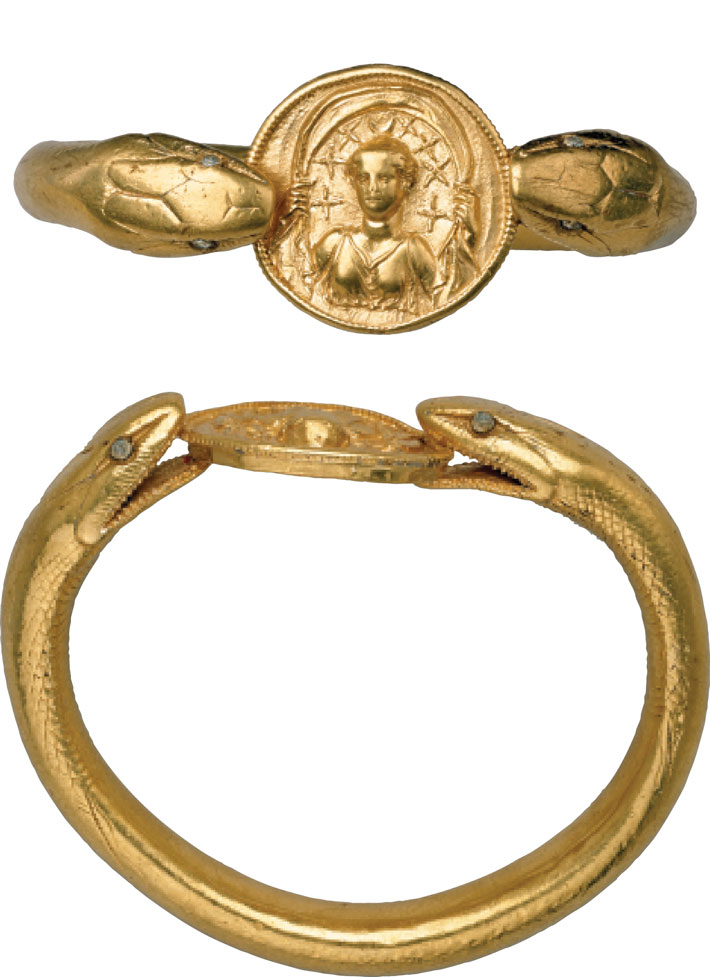 Giuseppe Fiorelli became director of excavations in Pompeii in 1860. Realizing that it was not just structures, paintings, mosaics, and artifacts that had been covered by volcanic debris, but also plants, animals, and people, Fiorelli developed a new method for recovering these once-living specimens. When excavators encountered voids in the hardened ash and pumice created by the decay of organic material, they poured plaster into them. They then left the plaster to dry, after which they removed the material around the plaster, revealing the bodies of victims at the very moments of their deaths.
Giuseppe Fiorelli became director of excavations in Pompeii in 1860. Realizing that it was not just structures, paintings, mosaics, and artifacts that had been covered by volcanic debris, but also plants, animals, and people, Fiorelli developed a new method for recovering these once-living specimens. When excavators encountered voids in the hardened ash and pumice created by the decay of organic material, they poured plaster into them. They then left the plaster to dry, after which they removed the material around the plaster, revealing the bodies of victims at the very moments of their deaths.
|
Slideshow:
|
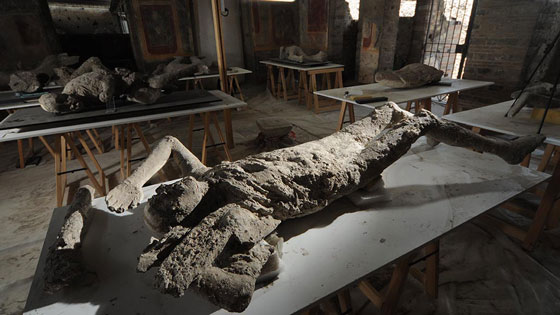
Casts of Pompeii
|
The Many Lives of an English Manor House
By KATE RAVILIOUS
Monday, December 21, 2015

If every home tells a story, then Knole House is a tome. By any measure one of the five largest houses in England, this country estate in Sevenoaks in west Kent has seen six centuries of British history, and the reigns of some 30 monarchs. Knole House has been the backdrop for all the ups and downs of the English aristocracy and for the lives of the countless tradesmen, butlers, maids, cooks, and footmen who kept dwellings like it running.
Located just 30 miles outside London, the house occupies four acres, surrounded by 26 acres of gardens and fields, and another thousand that make up a medieval deer park. If the house sprawls, it is with good reason. From Sir James Fiennes to the Archbishop of Canterbury to King Henry VIII to many generations of the Sackville family, each new owner has added to its size and complexity, which has resulted in a multilevel labyrinth. It is difficult even to get an accurate count of all the rooms—the best estimate is around 420, connected to courtyards, staircases, attics, and seemingly miles upon miles of corridors. “Knole has almost always had too many rooms,” says archaeologist Matthew Champion. “Each owner kept adding to it to increase their status, but they could never keep on top of using them all.”
Vita Sackville-West, the early-twentieth-century writer and inspiration for Virginia Woolf’s Orlando, grew up in the home and described it as resembling “a medieval village with its square turrets and its grey walls, its hundred chimneys sending blue threads up into the air.” Today, one wing is occupied by Robert Sackville-West, 7th Baron Sackville, and his family, but the house is owned and managed by the National Trust, to whom it was donated in 1947 by the 4th Baron, Charles. Supported by the Heritage Lottery Fund, the National Trust is conducting a major five-year program of restoration that is offering an unprecedented look at the house and grounds, its construction, and the lives of many of those who passed through its halls.
The project involves lifting floorboards, inspecting rafters, and repointing walls—an excavation of the house itself. Archaeologists have found, behind the walls and across the gardens, stories of the house’s occupants and employees, stories that reflect the changing moods of the country through time: the economic impact of the War of the Roses, the paranoia following the Gunpowder Plot, England’s obsession with sport, the arrival of modern technology—and, of course, generations of family intrigue.
The history of the site of Knole House goes back to well before the first block of dark-gray local Kentish ragstone was laid in 1445. Within the parkland around the estate are what appear to be the remnants of Bronze Age fields, patterns of irregular plots around one acre in size, according to Al Oswald, a landscape archaeologist from the University of Sheffield. A low hill in front of the house, called Echo Mount, may even be topped by a Bronze Age burial mound. “There’s been lots of speculation about which ‘knoll’ the place name refers to,” says Oswald. “I just wonder if this burial mound is the knoll, the local landmark, from which the house took its name.
|
Slideshow:
|

England’s Grand Estate
|
Top 10 Discoveries of 2015
By THE EDITORS
Monday, December 07, 2015
 This year’s Top 10 Discoveries reach us from vastly different cultures and across eons. Some raise new questions about what it means to be human and what separates us from our species’ relatives. Others bring us face to face with individual people, their travels, their faith, their hold on power. Several, covering matters as diverse as slavery and the origins of art, come to us via newly applied scientific methods. Taken together, this year’s discoveries present an array of insights into endeavors, large and small, spanning millions of years.
This year’s Top 10 Discoveries reach us from vastly different cultures and across eons. Some raise new questions about what it means to be human and what separates us from our species’ relatives. Others bring us face to face with individual people, their travels, their faith, their hold on power. Several, covering matters as diverse as slavery and the origins of art, come to us via newly applied scientific methods. Taken together, this year’s discoveries present an array of insights into endeavors, large and small, spanning millions of years.
Advertisement
DEPARTMENTS
Also in this Issue:
Advertisement
IN THIS ISSUE
Features
Top 10 Discoveries of 2015
The Many Lives of an English Manor House
Family History
Letter from Hawaii
From the Trenches
Reading the Invisible Ink
Off the Grid
Irish Roots
A Kestrel’s Last Meal
Pompeii Before the Romans
A Baltic Sea Monster Surfaces
Built upon Bones
An Opportunity for Early Humans in China
Hidden Blues
Mr. Jefferson’s Laboratory
Under a Haitian Palace
From Yacht to Trawler to Wreck
Buddha Stands Tall
Denmark’s Bog Dogs
Leftover Mammoth
Finding Parker’s Revenge
Living the Good Afterlife
Artifact
How a Medusa survived Christianity
Advertisement

Recent Issues
-
 May/June 2024
May/June 2024
-
 March/April 2024
March/April 2024
-
 January/February 2024
January/February 2024
-
 November/December 2023
November/December 2023
-
 September/October 2023
September/October 2023
-
 July/August 2023
July/August 2023
-
 May/June 2023
May/June 2023
-
 March/April 2023
March/April 2023
-
 January/February 2023
January/February 2023
-
 November/December 2022
November/December 2022
-
 September/October 2022
September/October 2022
-
 July/August 2022
July/August 2022
-
 May/June 2022
May/June 2022
-
 March/April 2022
March/April 2022
-
 January/February 2022
January/February 2022
-
 November/December 2021
November/December 2021
-
 September/October 2021
September/October 2021
-
 July/August 2021
July/August 2021
-
 May/June 2021
May/June 2021
-
 March/April 2021
March/April 2021
-
 January/February 2021
January/February 2021
-
 November/December 2020
November/December 2020
-
 September/October 2020
September/October 2020
-
 July/August 2020
July/August 2020
-
 May/June 2020
May/June 2020
-
 March/April 2020
March/April 2020
-
 January/February 2020
January/February 2020
-
 November/December 2019
November/December 2019
-
 September/October 2019
September/October 2019
-
 July/August 2019
July/August 2019
-
 May/June 2019
May/June 2019
-
 March/April 2019
March/April 2019
-
 January/February 2019
January/February 2019
-
 November/December 2018
November/December 2018
-
 September/October 2018
September/October 2018
-
 July/August 2018
July/August 2018
-
 May/June 2018
May/June 2018
-
 March/April 2018
March/April 2018
-
 January/February 2018
January/February 2018
-
 November/December 2017
November/December 2017
-
 September/October 2017
September/October 2017
-
 July/August 2017
July/August 2017
-
 May/June 2017
May/June 2017
-
 March/April 2017
March/April 2017
-
 January/February 2017
January/February 2017
-
 November/December 2016
November/December 2016
-
 September/October 2016
September/October 2016
-
 July/August 2016
July/August 2016
-
 May/June 2016
May/June 2016
-
 March/April 2016
March/April 2016
-
 January/February 2016
January/February 2016
-
 November/December 2015
November/December 2015
-
 September/October 2015
September/October 2015
-
 July/August 2015
July/August 2015
-
 May/June 2015
May/June 2015
-
 March/April 2015
March/April 2015
-
 January/February 2015
January/February 2015
-
 November/December 2014
November/December 2014
-
 September/October 2014
September/October 2014
-
 July/August 2014
July/August 2014
-
 May/June 2014
May/June 2014
-
 March/April 2014
March/April 2014
-
 January/February 2014
January/February 2014
-
 November/December 2013
November/December 2013
-
 September/October 2013
September/October 2013
-
 July/August 2013
July/August 2013
-
 May/June 2013
May/June 2013
-
 March/April 2013
March/April 2013
-
 January/February 2013
January/February 2013
-
 November/December 2012
November/December 2012
-
 September/October 2012
September/October 2012
-
 July/August 2012
July/August 2012
-
 May/June 2012
May/June 2012
-
 March/April 2012
March/April 2012
-
 January/February 2012
January/February 2012
-
 November/December 2011
November/December 2011
-
 September/October 2011
September/October 2011
-
 July/August 2011
July/August 2011
-
 May/June 2011
May/June 2011
-
 March/April 2011
March/April 2011
-
 January/February 2011
January/February 2011
Advertisement





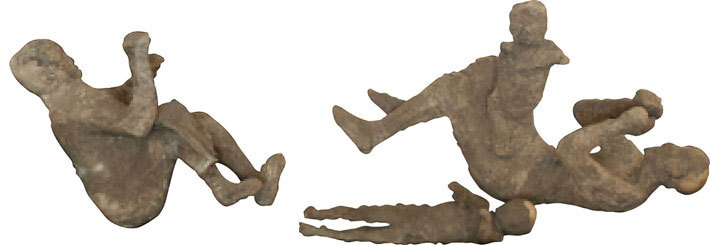
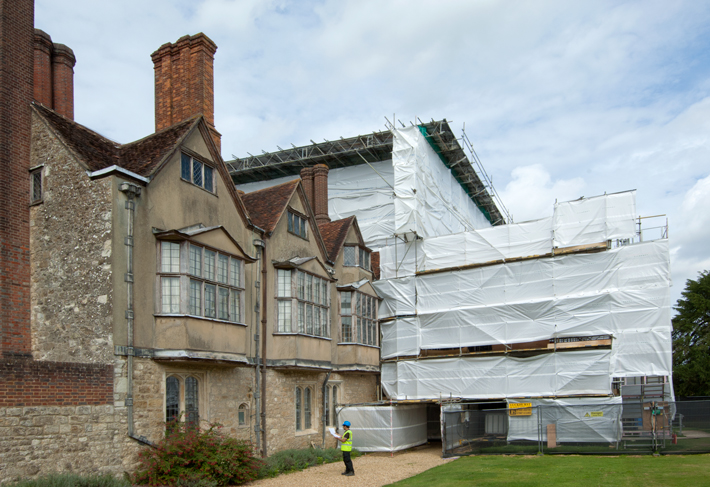 Next to Knole and thought to predate the house is a whopping great medieval stone barn, some 30 feet tall, enclosing an area the size of two tennis courts, that shows off the size of Knole’s agricultural estate even before there was a manor house to boast of. In the surrounding parkland, Oswald has also found “lynchets,” or terraces formed by plowed soil. The fields likely date to the same time as the barn, but wouldn’t have provided anywhere near enough grain to fill it. “It suggests that the barn was used to gather the harvest from a much wider area,” says Oswald. The estate appears to have already been productive when Sir James Fiennes, swashbuckling soldier and cunning politician (and distant ancestor of English adventurer Ranulph Fiennes), began to build a house in 1445 as a way to spend his ill-gotten spoil from the Hundred Years War. Alas, he was beheaded before he could finish the house, and his son sold it in 1456 to Thomas Bourchier, Archbishop of Canterbury, who completed the building works.
Next to Knole and thought to predate the house is a whopping great medieval stone barn, some 30 feet tall, enclosing an area the size of two tennis courts, that shows off the size of Knole’s agricultural estate even before there was a manor house to boast of. In the surrounding parkland, Oswald has also found “lynchets,” or terraces formed by plowed soil. The fields likely date to the same time as the barn, but wouldn’t have provided anywhere near enough grain to fill it. “It suggests that the barn was used to gather the harvest from a much wider area,” says Oswald. The estate appears to have already been productive when Sir James Fiennes, swashbuckling soldier and cunning politician (and distant ancestor of English adventurer Ranulph Fiennes), began to build a house in 1445 as a way to spend his ill-gotten spoil from the Hundred Years War. Alas, he was beheaded before he could finish the house, and his son sold it in 1456 to Thomas Bourchier, Archbishop of Canterbury, who completed the building works.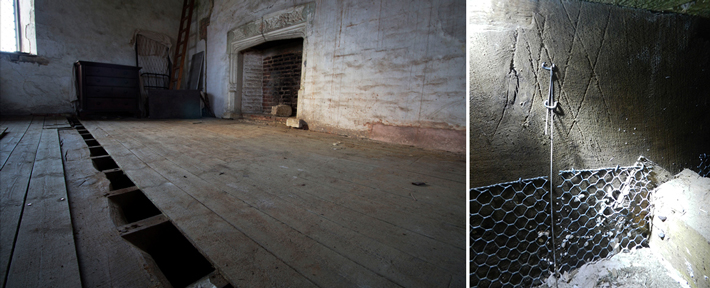
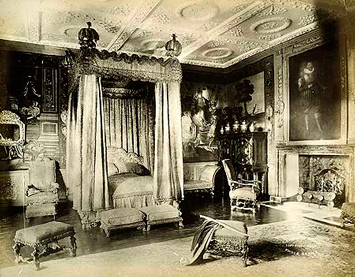 But times eventually calmed, and the succession of Sackvilles who inherited the house—all men, as specified in Thomas’ will—sometimes had more leisurely pursuits on their minds. Oswald spotted one of these interventions while walking through the parkland on a winter’s day, when a line of unmelted frost indicated a low embankment running parallel to the front of the house. He followed and mapped the feature and found that there had once been perfectly square, leveled lawns flanking a drive to the Outer Wicket Tower, a later addition that served as gatehouse to the Green Court.
But times eventually calmed, and the succession of Sackvilles who inherited the house—all men, as specified in Thomas’ will—sometimes had more leisurely pursuits on their minds. Oswald spotted one of these interventions while walking through the parkland on a winter’s day, when a line of unmelted frost indicated a low embankment running parallel to the front of the house. He followed and mapped the feature and found that there had once been perfectly square, leveled lawns flanking a drive to the Outer Wicket Tower, a later addition that served as gatehouse to the Green Court.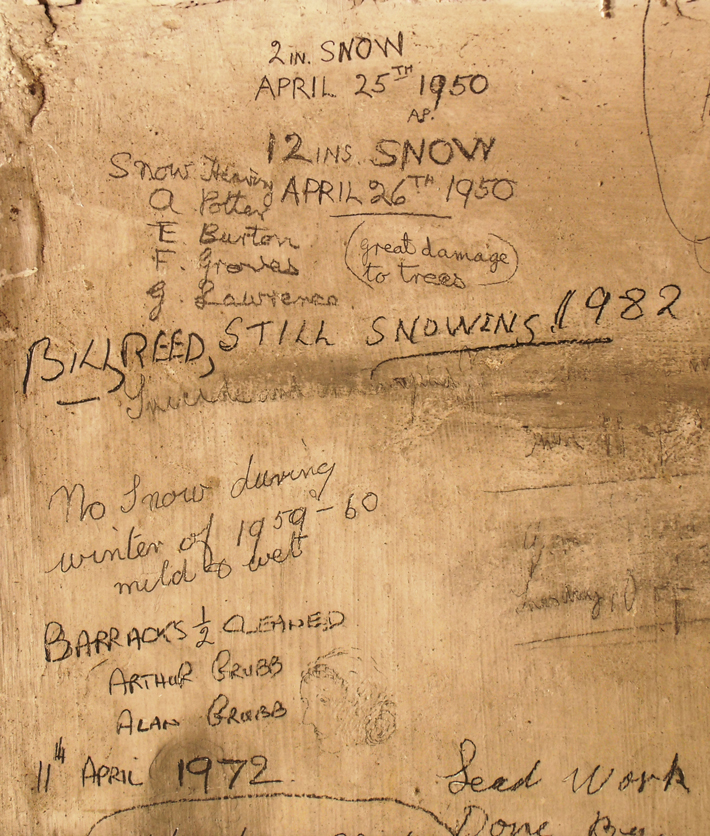 Any estate of the size and complexity of Knole House needs more than owners to keep it running. An army of servants, groundskeepers, housemaids, craftsmen, and more lived and worked in and around the house. While most of the remains in the house reflect the desires and tastes of its owners, others who spent their lives in service of Knole left evidence of their presence too. Long, narrow, dusty attics span the breadth of the house (about the length of a bowling lane), and archaeologist and graffiti expert Matthew Champion has found vast collections of graffiti scrawled there, on walls, rafters, and eaves.
Any estate of the size and complexity of Knole House needs more than owners to keep it running. An army of servants, groundskeepers, housemaids, craftsmen, and more lived and worked in and around the house. While most of the remains in the house reflect the desires and tastes of its owners, others who spent their lives in service of Knole left evidence of their presence too. Long, narrow, dusty attics span the breadth of the house (about the length of a bowling lane), and archaeologist and graffiti expert Matthew Champion has found vast collections of graffiti scrawled there, on walls, rafters, and eaves.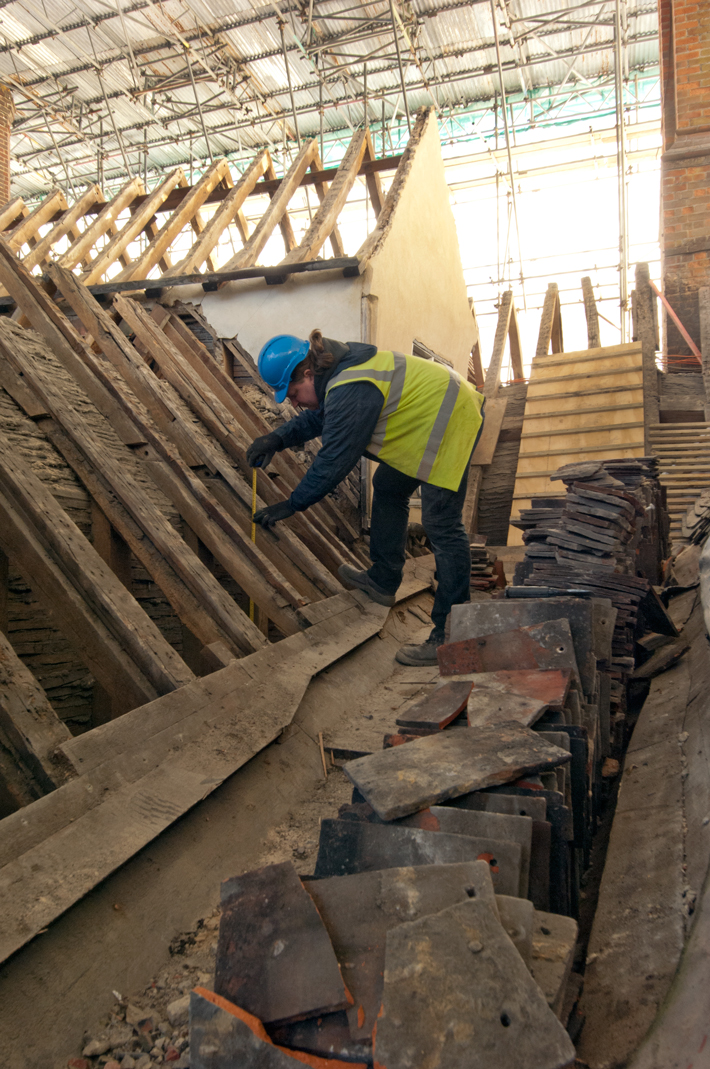 In other places, carpenter’s marks are visible, sometimes in a way that reflects the fortunes of the Sackvilles, which rose and fell as is common among such old families. Wright examined roof timbers on the eastern side of the house and saw unusual patterns. “We found that the carpenter’s marks—the numbers that carpenters scored into the timbers to remind them which piece went where—are all out of sequence,” he explains. The timbers are, surprisingly, a hodgepodge recycled from at least five different earlier roofs. During the eighteenth century, when these changes were made, there was likely some financial need to reuse older materials.
In other places, carpenter’s marks are visible, sometimes in a way that reflects the fortunes of the Sackvilles, which rose and fell as is common among such old families. Wright examined roof timbers on the eastern side of the house and saw unusual patterns. “We found that the carpenter’s marks—the numbers that carpenters scored into the timbers to remind them which piece went where—are all out of sequence,” he explains. The timbers are, surprisingly, a hodgepodge recycled from at least five different earlier roofs. During the eighteenth century, when these changes were made, there was likely some financial need to reuse older materials.